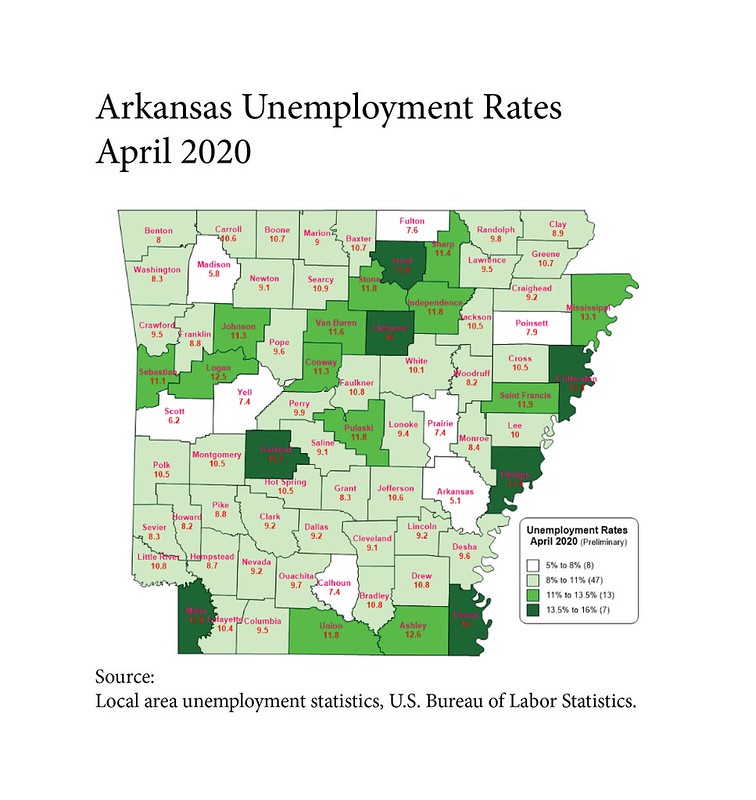June 10, 2020
Study: COVID-19 effects on Arkansas unemployment rates vary by county; urban rates outpaced rural
By Mary Hightower
U of A System Division of Agriculture
Fast Facts:
- COVID-19 hits tourism-related jobs hard in April
- April growth in urban unemployment outpaces rural rates
(386 words)
(Download this story in MS Word format here.)
LITTLE ROCK – The effect of COVID-19 on Arkansas’ unemployment rate in April varied by county, but also turned the typical rural versus urban unemployment rate trend on its head, according to a study released by the University of Arkansas System Division of Agriculture.
Wayne Miller, extension economist for the Division of Agriculture, is author of the study, “The COVID-19 Pandemic Affects Unemployment in Arkansas Counties Differently.”
The department’s faculty are part of the Dale Bumpers College of Agricultural, Food and Life Sciences and the Division of Agriculture.
Arkansas’ economy is familiar territory for Miller, who is also author of the bi-annual “Rural Profile of Arkansas,” a key work for policymakers: https://www.uaex.uada.edu/publications/pdf/MP551.pdf.
“The number of unemployed grew faster in urban counties” resulting in an urban unemployment rate of 10.8 percent, compared to the rural unemployment rate of 10 percent, Miller said. “Historically unemployment rates have been higher in rural counties.”
Miller noted that in rural counties, the unemployment rate varied from a little more than 5 percent in Arkansas County to 16 percent in Cleburne County.
“One possible reason for the high unemployment rate in Cleburne County is that the county economy relies heavily on the travel and tourism industry, which has been affected by the travel restrictions related to COVID-19,” he said.
Other rural counties with high unemployment rates approaching 14 percent are Chicot, Phillips and Izard counties.
“Although their unemployment rates increased between March and April of this year, these three counties had much higher unemployment rates than the statewide average even before the start of the COVID-19 pandemic,” Miller said.
Larger picture
The unemployment rates only tell part of the story of COVID-19’s impacts, Miller said.
“If we include those who dropped out of the labor force between March and April as part of the labor force and include them in the unemployment count, we get a somewhat different picture of unemployment in Arkansas,” he said. “The Arkansas ‘adjusted’ unemployment rate jumps from 10.2 percent to 14.6 percent in April 2020.”
The difference between urban and rural counties is smaller, with rural counties having a slightly higher average unemployment rate at 14.8 percent, compared to the urban counties at 14.5 percent, Miller said.
To learn about Division of Agriculture publications, contact your local Cooperative Extension Service agent or visit www.uaex.uada.edu. Follow us on Twitter at @AR_Extension.
About the Division of Agriculture
The University of Arkansas System Division of Agriculture’s mission is to strengthen agriculture, communities, and families by connecting trusted research to the adoption of best practices. Through the Agricultural Experiment Station and the Cooperative Extension Service, the Division of Agriculture conducts research and extension work within the nation’s historic land grant education system.
The Division of Agriculture is one of 20 entities within the University of Arkansas System. It has offices in all 75 counties in Arkansas and faculty on five system campuses.
Pursuant to 7 CFR § 15.3, the University of Arkansas System Division of Agriculture offers all its Extension and Research programs and services (including employment) without regard to race, color, sex, national origin, religion, age, disability, marital or veteran status, genetic information, sexual preference, pregnancy or any other legally protected status, and is an equal opportunity institution.
# # #
Media Contact: Mary Hightower
Chief Communications Officer
University of Arkansas System Division of Agriculture
mhightower@uada.edu
501-671-2006
